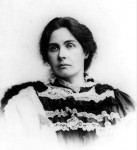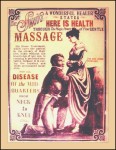 Constance Lloyd, wife of Oscar Wilde and mother of his two sons, was just 39 years old when she died. It was a botched gynecological operation that claimed her life, but for ten years before that she had suffered from a neurological disorder that hasn’t been identified. Now Merlin Holland, son of Constance and Oscar’s youngest son Vyvyan, has found key evidence in some of her private letters to her brother Otho.
Constance Lloyd, wife of Oscar Wilde and mother of his two sons, was just 39 years old when she died. It was a botched gynecological operation that claimed her life, but for ten years before that she had suffered from a neurological disorder that hasn’t been identified. Now Merlin Holland, son of Constance and Oscar’s youngest son Vyvyan, has found key evidence in some of her private letters to her brother Otho.
Constance was an accomplished woman in her own right. She was a published author of children’s books and an advocate for dress reform and women’s rights. After the disaster of Wilde’s 1895 criminal libel action against John Douglas, the 9th Marquess of Queensberry, father of his feckless idiot of a lover Alfred Douglas, for accusing him of sodomy and Wilde’s subsequent conviction and imprisonment for homosexual acts, Constance took the kids, changed their last name to Holland, and fled to the continent. They wound up in a small town outside Genoa, a location that would prove fateful since it put her in close proximity to Italian obstetrician and gynecologist Luigi Maria Bossi.
 Luigi Maria Bossi was appointed to the first professorship of gynecology in Italy in 1887. He invented a four-pronged dilator to dilate the cervix and speed up delivery in women with eclampsia and other dangerous conditions. The Bossi uterine dilator was an effective device, dilating the cervix in a matter of minutes and giving patients a chance to survive and heal from complications that were often fatal to mother and infant without having to risk surgery, infection and permanent damage to the reproductive organs.
Luigi Maria Bossi was appointed to the first professorship of gynecology in Italy in 1887. He invented a four-pronged dilator to dilate the cervix and speed up delivery in women with eclampsia and other dangerous conditions. The Bossi uterine dilator was an effective device, dilating the cervix in a matter of minutes and giving patients a chance to survive and heal from complications that were often fatal to mother and infant without having to risk surgery, infection and permanent damage to the reproductive organs.
He also opened an ob/gyn clinic in Genoa that reserved half the beds for poor women in labour, was vociferously opposed to the then-common idea that uterine cancer was contagious and advocated that women with tuberculosis not be compelled to terminate their pregnancies. He founded two gynecology and obstetrics journals, one for doctors and one for midwives.
 So he wasn’t a total quack, but he had … issues. In 1918 he was suspended from practice at the Institute for Gynecology and Obstetrics of the University of Genoa for two years over a question of “moral character,” which, considering that the next year he would be murdered by the husband of one of his patients, seems likely to have been a grossly unethical personal relationship with a patient (or several patients). Most relevant to his treatment of Constance Lloyd, Bossi was a dedicated proponent of the theory that women’s nervous problems — symptoms including tremors, aches and pains, fainting spells, shortness of breath, fatigue — were caused by their lady parts. Her “neuralgia,” mobility problems, exhaustion and all the rest were symptoms of uterine disorder and the cure for it was to be found in her reproductive organs.
So he wasn’t a total quack, but he had … issues. In 1918 he was suspended from practice at the Institute for Gynecology and Obstetrics of the University of Genoa for two years over a question of “moral character,” which, considering that the next year he would be murdered by the husband of one of his patients, seems likely to have been a grossly unethical personal relationship with a patient (or several patients). Most relevant to his treatment of Constance Lloyd, Bossi was a dedicated proponent of the theory that women’s nervous problems — symptoms including tremors, aches and pains, fainting spells, shortness of breath, fatigue — were caused by their lady parts. Her “neuralgia,” mobility problems, exhaustion and all the rest were symptoms of uterine disorder and the cure for it was to be found in her reproductive organs.
 That old hysteria chestnut had plagued Western medicine since Hippocrates first babbled about wandering uteri in the 5th century B.C., but it really took off with the rise of medical gynecology in the second half of the 19th century. The invention of the vibrator to cure hysteria through orgasm was a benign result of this misunderstanding of anatomy and psychology, but there were plenty of monstrous approaches attempted as well, a flurry of medical professionals removing ovaries and uteruses and then congratulating themselves on having “fixed” hysterical symptoms like dysmenhorrea (painful menstruation).
That old hysteria chestnut had plagued Western medicine since Hippocrates first babbled about wandering uteri in the 5th century B.C., but it really took off with the rise of medical gynecology in the second half of the 19th century. The invention of the vibrator to cure hysteria through orgasm was a benign result of this misunderstanding of anatomy and psychology, but there were plenty of monstrous approaches attempted as well, a flurry of medical professionals removing ovaries and uteruses and then congratulating themselves on having “fixed” hysterical symptoms like dysmenhorrea (painful menstruation).
Bossi believed that at least half of all female suicides were of gynecological origin, that suicide was somehow tied to menstruation, and that surgical interventions on the uterus and ovaries could cure the symptoms of hysteria. He persisted in his beliefs long after most of the ob/gyn community had abandoned hysteria to the province of psychiatry, publishing his theories in a German medical journal in 1911. The response was almost unanimous condemnation from gynecologists and psychiatrists. They considered the idea that the uterus was responsible for mental illness medically unfounded and socially dangerous since it would encourage families of mentally ill women to push them into needless gynecological surgery to avoid the madhouse. Only one prominent gynecologist, 84-year-old German gynecology professor Bernhard Schultze (who had for years been an advocate for gynecological surgery on inmates of insane asylums), supported him. Bossi wrote a book on hysteria and gynecology in 1917; it was the last gasp of this ugly chapter in medical history.
 The tide turned conclusively against the physiological hysteria theory thanks to painfully obvious studies published in the first couple of years of the 20th century. (It turns out, men had those exact same symptoms too, and they didn’t have any ovaries and uteruses to excise.) That was too late for Constance Lloyd. By the time she sought treatment from Bossi in late 1895, she was having severe difficulty walking. Bossi thought the cause of her mobility issues was a bladder prolapse that he could repair surgically, leaving her right as rain within six weeks. The operation took place in December of 1895. It didn’t work. In April of 1896, Constance declared herself “lamer than ever” and sought alternative therapies — galvanism, hot baths — from a doctor in Heidelberg.
The tide turned conclusively against the physiological hysteria theory thanks to painfully obvious studies published in the first couple of years of the 20th century. (It turns out, men had those exact same symptoms too, and they didn’t have any ovaries and uteruses to excise.) That was too late for Constance Lloyd. By the time she sought treatment from Bossi in late 1895, she was having severe difficulty walking. Bossi thought the cause of her mobility issues was a bladder prolapse that he could repair surgically, leaving her right as rain within six weeks. The operation took place in December of 1895. It didn’t work. In April of 1896, Constance declared herself “lamer than ever” and sought alternative therapies — galvanism, hot baths — from a doctor in Heidelberg.
All these therapeutic manoeuvres failed, and by October, 1896, in addition to the persistent lameness of her leg, a tremor appeared in her right arm. This so disrupted her handwriting that she was eventually forced to use a typewriter. “I am tired of doctors and no doctor finding out what to do with me,” she lamented. Moreover, she suffered protracted and excruciating headaches as well as extreme fatigue brought on by the mildest exertion. This was observed by her brother who, in July, 1897, noted that after only a few minutes’ walk to the station she collapsed on the road from exhaustion and had to be dragged to safety. And, if this was not enough, she developed a left facial palsy towards the end of her life.
According to the unpublished correspondence of Constance and her brother, her 9-year illness was characterised by widespread pains, right leg weakness, tremor of the right arm, profound fatigue, and a left facial paralysis. For the first 7 years the clinical picture was dominated by intermittent acute episodes followed by extended periods of recovery; in the last 2 years her disability became permanent with gradual deterioration. A likely diagnosis is multiple sclerosis of the relapsing-remitting type that subsequently developed into secondary progressive multiple sclerosis.
MS had been identified as a distinct disease and named in 1868 by French neurologist Jean-Martin Charcot. (Coincidentally, Charcot had some crazy ideas about hysteria too. He thought it was an inherited neurological disorder centered in the ovaries, uncurable but treatable with pressure on the ovary or ovariectomy and observable through hypnosis. Before his death in 1893 he would come to accept that hysteria was psychological in nature rather than neurological.) Multiple sclerosis was described in detail in an important neurology text by Sir William Gowers in 1888, but in the 1890s it still wasn’t widely known in the general medical profession.
In 1898, a desperate Constance returned to Bossi. This time he proposed that the culprit of her genitourinary and mobility problems was a uterine fibroid. She had surgery to remove the putative fibroid on April 2nd, 1898.
On the third or fourth postoperative day, Constance developed intractable vomiting. Profoundly dehydrated and in the absence of intravenous fluids, she grew progressively weaker, lapsed into unconsciousness, and died on April 7, 1898. This sequence of events suggests that she could have developed severe paralytic ileus, either as a direct result of the surgery or secondary to intra-abdominal sepsis.
Multiple sclerosis is associated with genitourinary symptoms in about two-thirds of female patients. It is conceivable, in Constance’s case, that the apparent pressure effects on the bladder (supposedly due to a fibroid) were really a manifestation of multiple sclerosis.